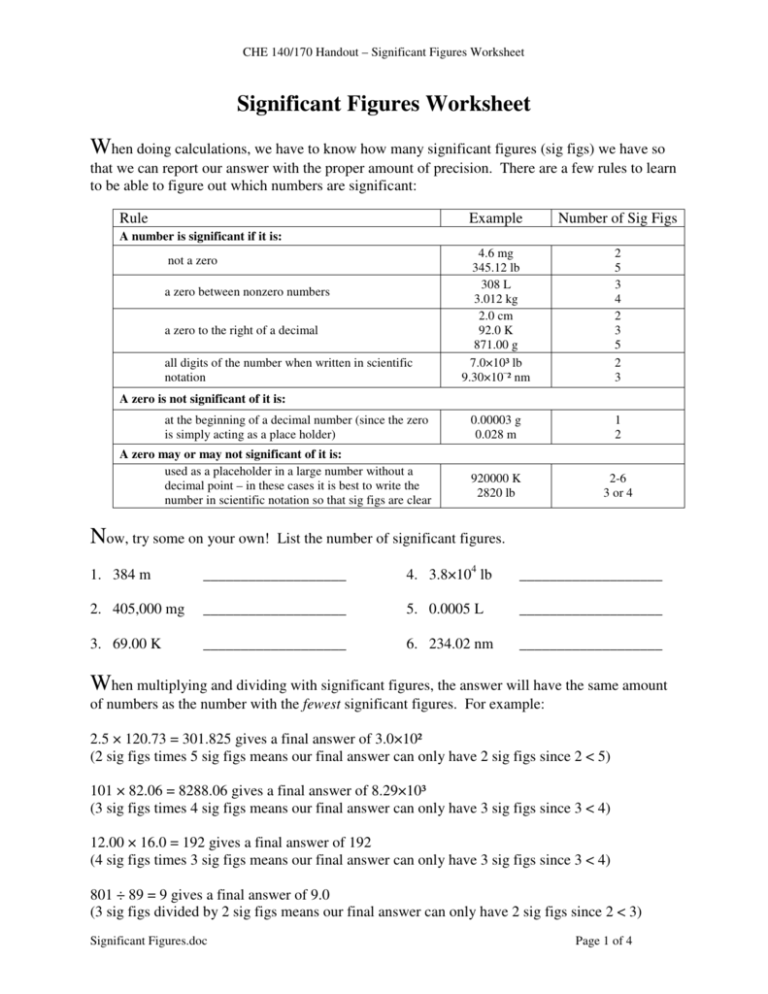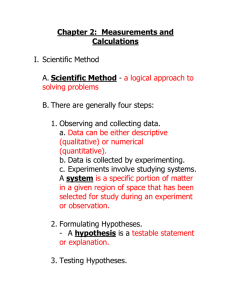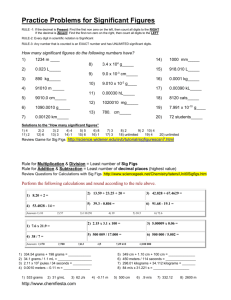Significant Figures Worksheet
advertisement

CHE 140/170 Handout – Significant Figures Worksheet Significant Figures Worksheet When doing calculations, we have to know how many significant figures (sig figs) we have so that we can report our answer with the proper amount of precision. There are a few rules to learn to be able to figure out which numbers are significant: Rule Example Number of Sig Figs 4.6 mg 345.12 lb 308 L 3.012 kg 2.0 cm 92.0 K 871.00 g 7.0×10³ lb 9.30×10–² nm 2 5 3 4 2 3 5 2 3 0.00003 g 0.028 m 1 2 920000 K 2820 lb 2-6 3 or 4 A number is significant if it is: not a zero a zero between nonzero numbers a zero to the right of a decimal all digits of the number when written in scientific notation A zero is not significant of it is: at the beginning of a decimal number (since the zero is simply acting as a place holder) A zero may or may not significant of it is: used as a placeholder in a large number without a decimal point – in these cases it is best to write the number in scientific notation so that sig figs are clear Now, try some on your own! List the number of significant figures. 1. 384 m ___________________ 4. 3.8×104 lb ___________________ 2. 405,000 mg ___________________ 5. 0.0005 L ___________________ 3. 69.00 K ___________________ 6. 234.02 nm ___________________ When multiplying and dividing with significant figures, the answer will have the same amount of numbers as the number with the fewest significant figures. For example: 2.5 × 120.73 = 301.825 gives a final answer of 3.0×10² (2 sig figs times 5 sig figs means our final answer can only have 2 sig figs since 2 < 5) 101 × 82.06 = 8288.06 gives a final answer of 8.29×10³ (3 sig figs times 4 sig figs means our final answer can only have 3 sig figs since 3 < 4) 12.00 × 16.0 = 192 gives a final answer of 192 (4 sig figs times 3 sig figs means our final answer can only have 3 sig figs since 3 < 4) 801 ÷ 89 = 9 gives a final answer of 9.0 (3 sig figs divided by 2 sig figs means our final answer can only have 2 sig figs since 2 < 3) Significant Figures.doc Page 1 of 4 CHE 140/170 Handout – Significant Figures Worksheet Your turn! Calculate the answers to the below problems. Then, report the answer with the correct number of significant figures. answer 7. 92.2 × 293.00 w/sig figs _________ _________ answer w/sig figs 10. 2.73 ÷ 458 _________ _________ 8. 0.0023 × 0.4800 _________ _________ 11. 18.00 × 351 _________ _________ 9. 546 ÷ 97.25 12. 827 × 0.01 _________ _________ _________ _________ When adding and subtracting with significant figures, the answer will have the same amount of numbers to the right of the decimal as the number with the fewest amount of number to the right of the decimal. For example: 75.346 + 4212.2 = 4387.546 gives a final answer of 4387.5 Since we have 3 decimal places plus 1 decimal place, our final answer can only have 1 decimal place because 1 < 3. It is easier to determine sig figs with addition and subtraction when we rewrite the problem as shown below. Then, we can draw a line indicating where the numbers switch from being significant to not being significant. 75.346 + 4312.2 . 4387.546 Let’s look at another example: 2.38×10–1 – 2.3×10–3 = 2.357×10–1 gives a final answer of 2.36×10–1 At first glance this answer might surprise you. However, we have a number with three decimal places having a number with four decimal places being subtracted from it. Thus, our final answer can only have three decimal places which in this case gives three significant digits. It is better to rewrite numbers in scientific notation so that they are either written to the same power of ten or written out in standard notation. This way, you can easily see which number truly has fewer decimals. Look at the problem rewritten below. 2.38×10–1 – 2.3×10–3 2.357×10–1 2.38×10–1 – 0.023×10–1 2.357×10–1 0.238 – 0.0023 0.2357 With the first way of writing, we can’t draw a line indicating where the numbers switch from being significant to not being significant. With the second two ways of rewriting, it is easy to draw the line to see where the digits switch from significant or not. To convert to the final answer of 2.36×10–1 we just have to remember our rounding rules. Significant Figures.doc Page 2 of 4 CHE 140/170 Handout – Significant Figures Worksheet It’s your turn again! Compute the answers with the correct number of significant figures. answer w/sig figs answer w/sig figs 13. 92.201 + 293.00 _________ _________ 16. 27.31 – 0.589 _________ _________ 14. 0.0023 – 0.480 _________ _________ 17. 9.583×10–2 + 4.28×10-4 _________ _________ 15. 654 + 79.5 _________ _________ 18. 3.46817×10–13 + 8.43×10-18 _________ _________ Now that you have learned the major rules for calculations with significant figures, try these problems! Remember to follow the proper computation order! work with calculator given answer answer with proper sig figs 3.12 + 546.1 62.101 _______________ 20. 305.75 ÷ 546 _______________ 19. 6.022 × 10 23 14.60 _______________ 22. 15.3 × (0.1296 + 0.549) ÷ 1.2 _______________ 9.583 × 10 −2 23. 4.23 × 10 − 4 _______________ 24. 10.59602 + 2.109867×10–3 _______________ 21. 54.2 × 25. 5.55 + 6.03 × 10 −8 1.239 × 10 3 26. 12.01 + 5.20 × 0.00310 Significant Figures.doc _______________ _______________ Page 3 of 4 CHE 140/170 Handout – Significant Figures Worksheet The last rule about significant figures deals with logarithms. First when we take the logarithm of a number, there are special names for the result: the number to the left of the decimal is called the characteristic and the number to the right is called the mantissa. The significant figures rule says that the mantissa needs to have the same number of significant figures as the original number. Let’s look at some examples: log 34.7 = 1.540329 gives a final answer of 1.540 (our original number has 3 sig figs, so our final answer must have 3 decimal places) ln 4.3 = 1.458615 gives a final answer of 1.46 (our original number has 2 sig figs, so our final answer must have 2 decimal places) 10–87.6 = 2.51189×10–88 gives a final answer of 3×10–88 (the mantissa only had 1 decimal place, so the final answer can only have 1 significant figure) e1.687 = 5.403247 gives a final answer of 5.40 (the mantissa had 3 decimal places, so the final answer must have 3 significant figures) Now it’s your turn again. answer w/sig figs answer w/sig figs 27. log 5.89×10–3 ____________ _________ 29. 10–2.22 ____________ _________ 28. ln 3.591 30. e56.1 ____________ _________ ____________ _________ Significant Figures.doc Page 4 of 4






